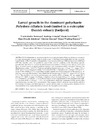Please use this identifier to cite or link to this item:
https://accedacris.ulpgc.es/jspui/handle/10553/75536
| Title: | Larval growth in the dominant polychaete Polydora ciliata is food-limited in a eutrophic Danish estuary (Isefjord) | Authors: | Pedersen, TM Almeda García, Rodrigo Fotel, FL Jakobsen, HH Mariani, P Hansen, BW |
UNESCO Clasification: | 251001 Oceanografía biológica | Keywords: | Food limitation Larval growth Polydora ciliata Larvae |
Issue Date: | 2010 | Journal: | Marine Ecology - Progress Series | Abstract: | Food limitation in larval growth of the spionid polychaete Polydora ciliata was examined in a typical eutrophic estuary, Isefjord, in Denmark. In the field, food availability and the energetic requirements of the P. ciliata larval population were measured during 2 different periods in 2004 and 2007 that together cover the productive part of the year for plankton. In the laboratory, specific growth rates (µ) of larvae reared on natural food suspensions (~0.10 d–1) were always lower than those of larvae reared on phytoplankton-enriched food suspensions (100% retention efficiency for Rhodomonas salina; ~0.21 d–1). Total meroplankton biomass (average: 3.72 µg C l–1, range: 0.11 to 26.05 µg C l–1) was frequently similar to or exceeded that of holoplankton (average: 5.70 µg C l–1, range: 0.08 to 29.89 µg C l–1), suggesting a trophic significance of meroplankton in the estuary. P. ciliata was commonly the dominant meroplanktonic larvae (average: 0.5 µg C l–1, range: 0.03 to 2.51 µg C l–1). The available food in the optimal prey size fraction (2004, average: <20 µm; range: 99 to 274 µg C l–1; 2007, average: 7 to 18 µm; estimated carbon demand: 119 µg C l–1; range: 19 to 474 µg C l–1) seemed to be sufficient to cover the energetic carbon requirements of the population throughout the study (0.09 to 3.15 µg C l–1 d–1), but insufficient to attain the maximum specific growth rates reported in previous laboratory experiments. This suggests that P. ciliata larvae probably exhibit a low feeding efficiency and their maximum specific growth rates are consequently attained at food concentrations even higher than those found in this eutrophic environment. | URI: | https://accedacris.ulpgc.es/handle/10553/75536 | ISSN: | 0171-8630 | DOI: | 10.3354/meps08563 | Source: | Marine Ecology - Progress Series [ISSN 0171-8630], v. 407, p. 99-110 |
| Appears in Collections: | Artículos |
WEB OF SCIENCETM
Citations
16
checked on Jun 8, 2025
Page view(s)
92
checked on May 11, 2024
Download(s)
70
checked on May 11, 2024
Google ScholarTM
Check
Altmetric
Share
Export metadata
Items in accedaCRIS are protected by copyright, with all rights reserved, unless otherwise indicated.
